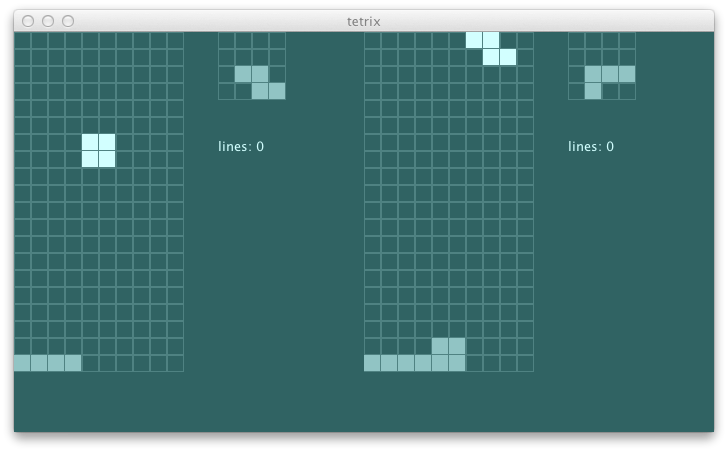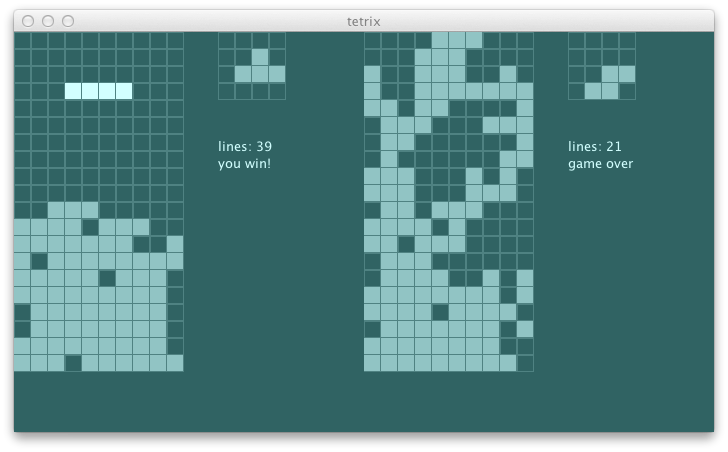tetrix in Scala — man vs machine
man vs machine
Now that the agent is tuned, the next logical step is to play against the human. Let’s set up two stage actors with identical initial state. One controlled by the player, and the other controlled by the agent.
private[this] val initialState = Stage.newState(Nil,
(10, 23), Stage.randomStream(new util.Random))
private[this] val system = ActorSystem("TetrixSystem")
private[this] val stateActor1 = system.actorOf(Props(new StateActor(
initialState)), name = "stateActor1")
private[this] val stageActor1 = system.actorOf(Props(new StageActor(
stateActor1)), name = "stageActor1")
private[this] val stateActor2 = system.actorOf(Props(new StateActor(
initialState)), name = "stateActor2")
private[this] val stageActor2 = system.actorOf(Props(new StageActor(
stateActor2)), name = "stageActor2")
private[this] val agentActor = system.actorOf(Props(new AgentActor(
stageActor2)), name = "agentActor")
private[this] val masterActor = system.actorOf(Props(new GameMasterActor(
stateActor2, agentActor)), name = "masterActor")
private[this] val tickTimer1 = system.scheduler.schedule(
0 millisecond, 701 millisecond, stageActor1, Tick)
private[this] val tickTimer2 = system.scheduler.schedule(
0 millisecond, 701 millisecond, stageActor2, Tick)
masterActor ! Start
def left() { stageActor1 ! MoveLeft }
def right() { stageActor1 ! MoveRight }
def up() { stageActor1 ! RotateCW }
def down() { stageActor1 ! Tick }
def space() { stageActor1 ! Drop }
Currently view returns only one view. We should modify this to return a pair.
def views: (GameView, GameView) =
(Await.result((stateActor1 ? GetView).mapTo[GameView], timeout.duration),
Await.result((stateActor2 ? GetView).mapTo[GameView], timeout.duration))
Next, the swing UI need to render both the views.
def onPaint(g: Graphics2D) {
val (view1, view2) = ui.views
val unit = blockSize + blockMargin
val xOffset = mainPanelSize.width / 2
drawBoard(g, (0, 0), (10, 20), view1.blocks, view1.current)
drawBoard(g, (12 * unit, 0), view1.miniGridSize, view1.next, Nil)
drawStatus(g, (12 * unit, 0), view1)
drawBoard(g, (xOffset, 0), (10, 20), view2.blocks, view2.current)
drawBoard(g, (12 * unit + xOffset, 0), view2.miniGridSize, view2.next, Nil)
drawStatus(g, (12 * unit + xOffset, 0), view2)
}
def drawStatus(g: Graphics2D, offset: (Int, Int), view: GameView) {
val unit = blockSize + blockMargin
g setColor bluishSilver
view.status match {
case GameOver =>
g drawString ("game over", offset._1, offset._2 + 8 * unit)
case _ => // do nothing
}
g drawString ("lines: " + view.lineCount.toString, offset._1, offset._2 + 7 * unit)
}
Since drawBoard was refactored out, this was simple.

We can let GameMasterActor be the referee and determine the winner if the other loses.
case object Victory extends GameStatus
...
class GameMasterActor(stateActor1: ActorRef, stateActor2: ActorRef,
agentActor: ActorRef) extends Actor {
...
private[this] def getStatesAndJudge: (GameState, GameState) = {
var s1 = getState1
var s2 = getState2
if (s1.status == GameOver && s2.status != Victory) {
stateActor2 ! SetState(s2.copy(status = Victory))
s2 = getState2
}
if (s1.status != Victory && s2.status == GameOver) {
stateActor1 ! SetState(s1.copy(status = Victory))
s1 = getState1
}
(s1, s2)
}
}
We need to display the status on the UI:
case Victory =>
g drawString ("you win!", offset._1, offset._2 + 8 * unit)
And this is how it looks:

Next Page
❧
attacks